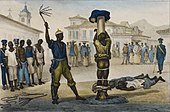
Back Lyfstraf in skole Afrikaans عقوبة بدنية مدرسية Arabic ضرب التلامذه ARZ Körperstrafen in der Kindererziehung German Σωματική τιμωρία στο σχολείο Greek ענישה גופנית בבית הספר HE Hukuman fisik di sekolah ID Punizioni corporali nelle scuole Italian 学校内における体罰 Japanese 교내 체벌 Korean
| Part of a series on |
| Corporal punishment |
|---|
 |
| By place |
| By implementation |
| By country |
| Court cases |
| Politics |
| Campaigns against corporal punishment |
School corporal punishment is the deliberate infliction of physical pain as a response to undesired behavior by students. The term corporal punishment derives from the Latin word for the "body", corpus. In schools it may involve striking the student on the buttocks or on the palms of their hands[1][2] with an implement such as a rattan cane, wooden paddle, slipper, leather strap, belt, or wooden yardstick. Less commonly, it could also include spanking or smacking the student with an open hand, especially at the kindergarten, primary school, or other more junior levels.[3]
Much of the traditional culture that surrounds corporal punishment in school, at any rate in the English-speaking world, derives largely from British practice in the 19th and 20th centuries, particularly as regards the caning of teenage boys.[4] There is a vast amount of literature on this, in both popular and serious culture.[5][6]
In the English-speaking world, the use of corporal punishment in schools has historically been justified by the common-law doctrine in loco parentis, whereby teachers are considered authority figures granted the same rights as parents to discipline and punish children in their care if they do not adhere to the set rules. A similar justification exists in Chinese-speaking countries.[7] It lets school officials stand in for parents as comparable authority figures.[8] The doctrine has its origins in an English common-law precedent of 1770.[9]
According to General Social Survey, 84 percent of American adults in 1986 believed that "children sometimes need a good spanking". There is hardly any evidence that corporal punishment improved a child's behavior as time goes by. On the other hand, substantial evidence is found that it puts children "at risk for negative outcomes," for it may result in increased aggression, antisocial behavior, mental health problems, and physical injury.[10]
Poland was the first nation to outlaw corporal punishment in schools in 1783. School corporal punishment is no longer legal in European countries except for Belarus, Vatican City (however, there are no primary or secondary schools in Vatican City) and unrecognized Transnistria. By 2016, an estimated 128 countries had prohibited corporal punishment in schools, including nearly all of Europe and most of South America and East Asia. Approximately 69 countries still allow corporal punishment in schools, including parts of the United States and many countries in Africa and Asia.[11]
- ^ "Corporal Punishment in Schools". American Academy of Child and Adolescent Psychiatry. September 2014.
- ^ Cite error: The named reference
torontowas invoked but never defined (see the help page). - ^ "Write an article for publication in your schools magazine on why corporal punishment should be retained only - Brainly.in". Archived from the original on 17 November 2023. Retrieved 12 January 2025.
- ^ "United Kingdom: Corporal punishment in schools". World Corporal Punishment Research.
- ^ Quigly, Isabel (1984). The Heirs of Tom Brown: The English School Story. Oxford University Press. ISBN 0-19-281404-4
- ^ Chandos, John (1984). Boys Together: English Public Schools 1800-1864. London: Hutchinson, esp. chapter 11. ISBN 0-09-139240-3
- ^ Lu, Joy (27 May 2006). "Spare the rod and spoil the child?". China Daily. Beijing. Retrieved 11 February 2020.
- ^ Cite error: The named reference
Pediatricianswas invoked but never defined (see the help page). - ^ Cite error: The named reference
SAM2003was invoked but never defined (see the help page). - ^ Gershoff, E.T.; Font, S.A. (2016). "Corporal punishment in U.S. public schools: Prevalence, disparities in use, and status in state and federal policy" (PDF). Social Policy Report. 30: 1–26. doi:10.1002/j.2379-3988.2016.tb00086.x. PMC 5766273. PMID 29333055.
- ^ Gershoff, Elizabeth (2017). "School corporal punishment in global perspective: prevalence, outcomes, and efforts at intervention". Psychology, Health & Medicine. 22 (sup1): sup1, 224–239. doi:10.1080/13548506.2016.1271955. PMC 5560991. PMID 28064515.